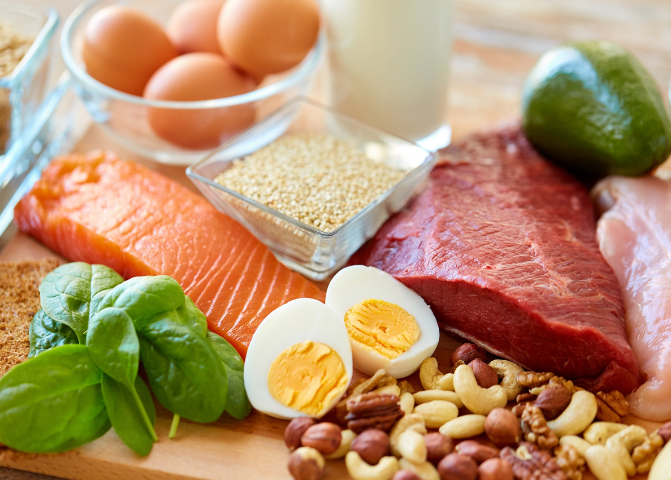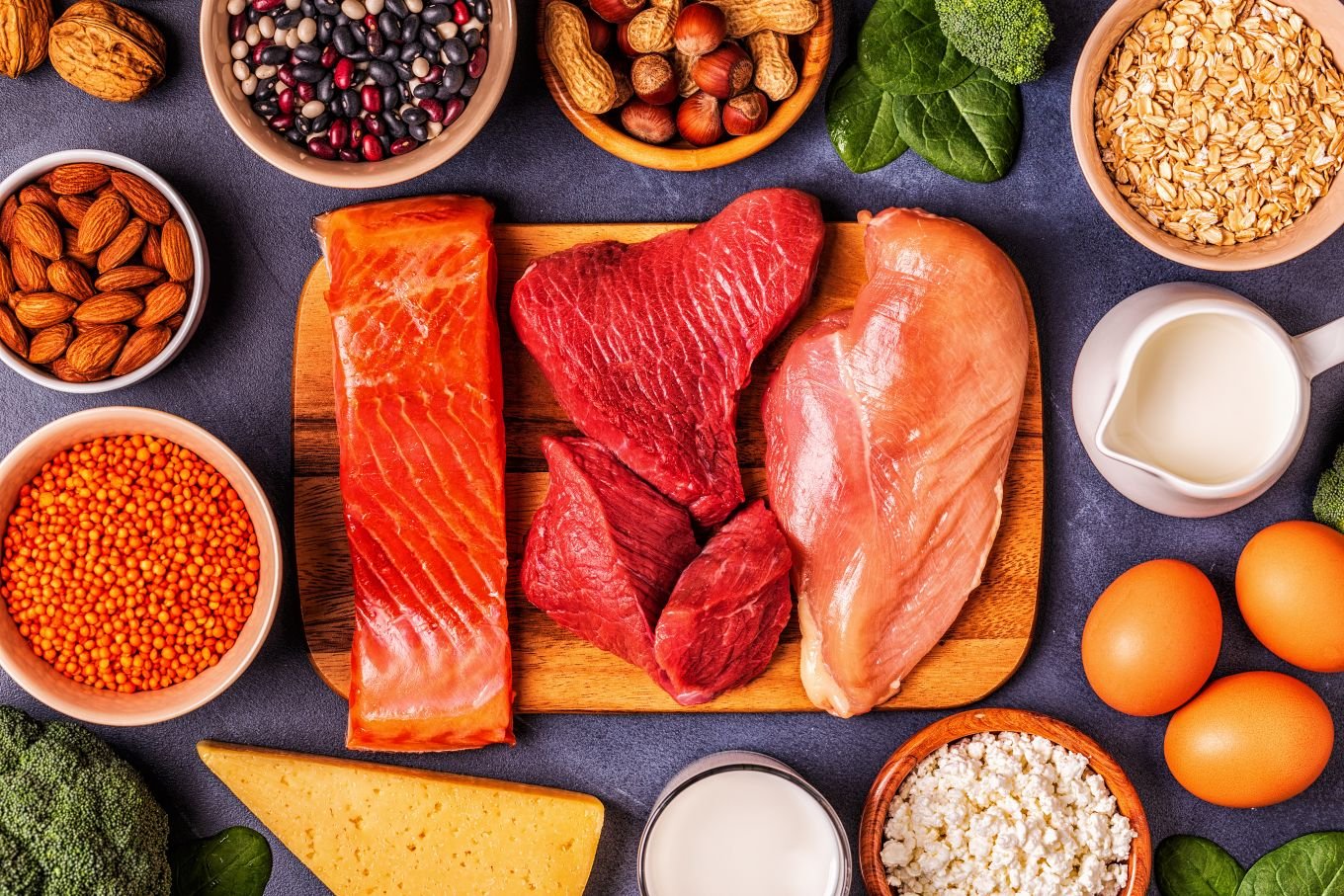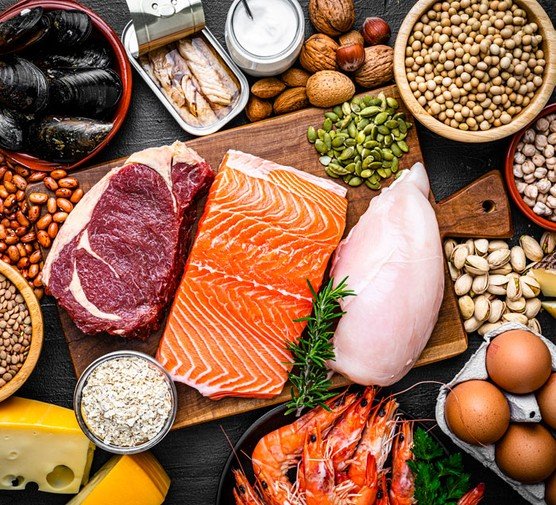Definition of Protein – This book covers the entire syllabus of “Nutrition and Dietetics” prescribed by BNMC-for all Diploma in Nursing Science and Midwifery students. We tried to accommodate latest information and topics. This book is examination friendly setup according to the teachers’ lectures and examination’s questions. At the end of the book previous university questions are given. We hope in touch with the book students’ knowledge will be upgraded and flourished. The unique way of presentation may make your reading of the book a pleasurable experience.

Definition of Protein
Protein is one of the three nutrients found in food that the body requires in large amounts. Along with carbohydrates and fat, protein is essential for the human body.
Proteins are made of small compounds called amino acids. There are hundreds of amino acids that exist in nature, but the human body only utilizes 22 of them.
The human body can produce all but nine of the amino acids that it needs. These nine are called essential amino acids and must be consumed through food.
All foods contain differing combinations of amino acids, making a balanced diet essential. In general, animal proteins like meat, dairy, and eggs contain all the essential amino acids.
Plant-based proteins from foods like beans, grains, nuts, and soy are rich in some amino acids but may be lacking in others. This lack underlines the need for a well-balanced diet with variety.
Protein:
Protein are complex organic nitrogenous compounds composed of carbon (C), hydrogen (H), oxygen (O), nitrogen (N), sulphur (S) in varying amounts. Some proteins also contain phosphorous and iron and occasionally other elements.
(Ref by: K. Park/24/647)
[OTHER DEFINITIONS – NICE TO KNOW]
- Proteins are complex organic nitrogenous compounds. They are made up of carbon, hydrogen, nitrogen and sulpher and in some contains phosphorous. Proteins are essential for the growth and development of the body. It is very essential for development of brain. Deficiency of protein uses mental retardation and growth retardation. The quality of protein depends upon the presence of number of amino acids.
(Ref: Olina Salin’s Essential Nutrition/1/19)
- Proteins are organic substances which contain carbon, hydrogen, nitrogen, oxygen and other elements. It is main constituent of the body cell.
- Protein may be defined as organic substance that on digestion yield their constituent, unit building blocks- the amino acids. In other words, amino acids unite to form the complex molecule of protein.
Classification of Protein:
| 1. First class protein or high biological value of protein/biological complete proteins: | When protein contains all the essential amino acids in amounts corresponding to human needs it is said to be high biological value.
|
| 2. Second class protein or low biological value of protein or biologically in complete protein | When one or more of the essential amino acids are lacking, the protein is said to be low biological value.
It is also called second-class protein or biologically incomplete protein. |
OTHER CLASSIFICATION-NICE TO KNOW]
| 1. Simple proteins: |
|
| 2. Conjugate proteins: |
|
| 3. Derived proteins: |
|
(Ref by: Olina Salin’s Essential Nutrition/1/11)

Sources of Protein:
1. Animal sources: Meat, fish, milk, milk products (such as butter, ghee, cheese, yougurt), poultry birds, sausages etc.
2. Plant or vegetable sources: Pulse, oil seeds cakes etc. nuts, groundnuts, legumes, dhals, cashew nut, beans.
Daily protein requirement in different age:
| Age | Requirement |
| Children | 35-60gm |
| Adolescence | 70-80gm |
| Adult male | 70-80gm |
| Adult female | 60-70gm |
| Pregnant woman | 90 gm |
| Lactating mother | 100 gm |
Functions of Protein:
1. Protein helps growth and development and repair of the body and body cell.
2. Takes part in defense mechanism of the body.
3. Synthesis of certain substance like antibodies, plasma proteins, hemoglobin, enzymes, hormones and coagulation factors.
4. Maintenance of osmotic pressure.
5. Helps in metabolic processes with enzymes.
DETAIL FUNCTIONS OF PROTEIN – NICE TO KNOW]
| Build and repair body tissues | Proteins form integral parts of most body structure such as skin, tendon, membranes, muscles, organs and bones. They support the growth and repair of body tissues. |
| Enzymes | (eg) Lipase helps to breakdown fat and sucrose breaks down sugar. |
| Hormones | Regulate body process. |
| Antibodies | Inactivate foreign invaders thus protecting the body against disease. |
| Fluid & electrolyte balance | Proteins help to maintain the volume and composition of body fluids. |
| Acid-base balance | Proteins help maintain the acid-base balance of the body fluids by acting as buffers. |
| Energy | Proteins provide fuel for the body’s energy needs [4 KCal/gm]. |
| Storage | Proteins help to store iron and copper. |
| Homeostasis | Proteins maintain normal osmotic balance among body fluids. |
| Transport proteins (eg) Haemoglobin, lipoprotein | These type of proteins carry nutrients to the tissues. eg lipoprotein carry lipids, haemoglobin transports oxygen. |
| Contribute to sensory & Physical properties of food | Proteins impart colour, flavour, odour and texture to foods. |
Effects of Protein Deficiency:
| 1. During pregnancy: |
|
| 2. Infancy and early childhood.: |
|
| 3. Adults: |
|
(Ref by: K. Park/24h/648)

Reference Protein:
Reference protein is that protein in which all essential amino acids are present. The reference protein is one which would produce 1 gm of tissue for each gm consumed thus it would have a biological value of 100.
Egg is called reference protein because of the following reason:
In 1965 the FAO/WHO committee recommended that egg could be used as reference protein.
1. It is high biological value & highly digestible.
2. It contains all essential amino acids in adequate amounts.
3. 100% absorbable.
The Body Uses Protein:
1. To build new tissues and fluids, especially for growth in children and pregnant and breastfeeding women.
2. To replace lost amino acids. When cells in the body die, the protein in them breaks down into amino acids. The uses some amino acids again, but some are lost in the urine. So everyone needs some protein to replace these lost amino acids. During illness amino acids may be loss faster than normal.
3. To help the cells to work.
4. To protect the body against infections.
5. As fuel for energy. A person uses protein from food for energy.
(Ref by: Nutrition for developing countries/24/26)
Digestion, Absorption & Utilization of Protein:
Proteins taken in the diet are digested to amino acids in the stomach and small intestine. Gastric juice contains enzymes pepsin which digests protein in acid medium. It hydrolyses proteins to polypeptides.
Absorption of protein:
- Proteins are mainly absorbed in the form of amino acids.
- Amino acids are absorbed by active transport mechanism in the intestinal cells. Sometimes whole protein may be absorbed by the mechanism of pinocytosis.
- Absorbed amino acids pass into the portal blood and reach liver where they are converted to proteins. Other amino acids are transported through general circulation and are utilized for protein synthesis in the tissues.
Utilization of protein:
Please write the details function of protein from above
Protein Containing Food:
| Food Stuff | Protein % |
| Rich Sources: | |
| Meat, fish and liver | 18-20 |
| Eggs | 14 |
| Milk powder, full fat | 26 |
| Milk powder, skimmed | 33 |
| Cheese | 18-20 |
| Pulses | 18-24 |
| Nuts and oilseeds | 18-26 |
| Soyabean | 35-40 |
| Good Sources: | |
| Cereals and millets | 6-12 |
| Tender legumes, green peas, cow peas | 7-8 |
| Fair | |
| Potato | 2 |
| Green leafy vegetables | 2-6 |
(Ref by: Swaminathan. M./Principles of Nutrition and Dietetics)
Extra protein is needed for them who suffers from marasmus, kwashiorkor, mental retardation, protein deficiency anaemia, premature babies, loss of weight, underweight etc. problem. Extra protein is needed during pregnancy, infant and early childhood.

Importance of Supplementary Actions of Proteins:
Man derives protein not from a single source, but from a variety of food sources, animal and vegetable. Cereal proteins are deficient in lysine and threonine; and pulse proteins in methionine. These are known as “limiting” amino acids. Where two or more vegetarian foods are eaten together (e.g. rice-dal combination) there proteins supplement one another and provide a protein comparable to animal protein in respect of essential amino acids.
Thus with proper planning, it is possible for a vegetarian to obtain a high grade protein, at low cost, from mixed diets of cereals, pulses and vegetables. This is known as supplementary action of proteins, and is the basis of counseling people to eat mixed diets.
Read more:
